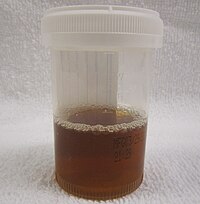
Photo from wikipedia
The aim of this study was to explore the clinical utility of urinary L-FABP for earlier prediction of acute kidney injury (AKI) after emergency laparotomy, and to assess the clinical… Click to show full abstract
The aim of this study was to explore the clinical utility of urinary L-FABP for earlier prediction of acute kidney injury (AKI) after emergency laparotomy, and to assess the clinical utility of a point-of-care (POC) kit for urinary L-FABP. Forty-eight patients undergoing emergency laparotomy were divided into AKI and non-AKI groups by the kidney diseases: improving global outcome (KDIGO) criteria. Ten patients were included in the AKI group. Urinary L-FABP, albumin, N-acetyl-β-d-glucosaminidase (NAG), TIMP-2, IGFBP7, serum creatinine (SCr), and blood presepsin were measured perioperatively and compared between groups. Perioperative urinary L-FABP was also evaluated qualitatively using a POC kit. L-FABP and albumin levels were significantly higher in the AKI group at all measurement points. NAG was significantly higher only postoperatively in the AKI group. There were no inter-group differences in [TIMP-2] × [IGFBP7] at any measuring point. The area under the receiver operating characteristic curve of urinary L-FABP was greater than 0.8 perioperatively, which was larger than that of other biomarkers throughout the study period. The correlation coefficient at 2 h after entering the operating room between quantitative and qualitative tests for urinary L-FABP was 0.714, which was the maximum. The sensitivity, specificity, and negative predictive value of the urinary L-FABP POC kit at 2 h after entry were 55.6%, 91.9%, and 89.5%, respectively. Quantitative L-FABP analyses is suitable for predicting postoperative AKI earlier in the perioperative period of emergency laparotomy. Conversely, the higher specificity of qualitative L-FABP analysis suggests that it may be useful for excluding the risk of AKI but its overall clinical validity should be further investigated.
Journal Title: Journal of Anesthesia
Year Published: 2021
Link to full text (if available)
Share on Social Media: Sign Up to like & get
recommendations!